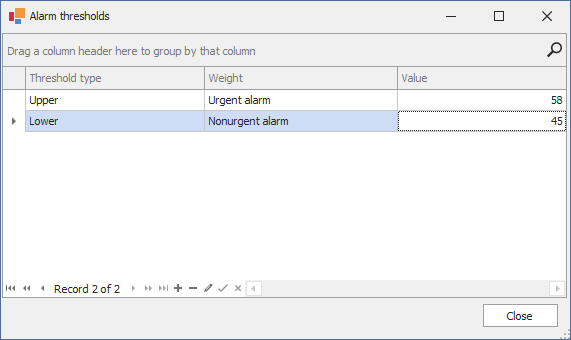The purpose of alarm thresholds functionality is to extend possibilities of alarming when preset value has been exceeded.
It is the server which analyses values and generates alarms. After reception of the measurement (possibly the event) the server verifies if configuration of the signal includes preset alarm thresholds. If there are a few thresholds which meet the condition, only one event is generated (the highest one). Each threshold includes particular type (high or low) and type of weight. Alarms generated on a basis of thresholds are of higher priority in comparison with the alarms received from the controller. Discretional number of thresholds may be associated to a single signal.
Definition of the threshold operates when value of the signal is higher than value of high threshold(s) or lower than the value of low threshold(s).
Sorts of thresholds:
There are 6 levels of the alarm’s importance (from 1 to 6). Default value is 3.
List of weights:
6 – critical 5 – urgent – alarm 4 – important 3 – non-urgent – notification 2 – information 1 – no alarm
There is a special meaning of “0” weight. It allows switching off the alarm generated by the controller or by lower threshold.
Example 1 Battery temperature alarming threshold was set at 30°C in the controller. However this value is too low and the administrator would like to modify it to 40°C. In such situation it is possible to set the threshold with weight 1 at a value of 29°C what will result in switching off the alarm from the controller. The second threshold with weight 5 set at 40°C will cause generation of correct alarm.
Example 2 Status of the inverter equals to integer numbers from 0 to 4. Value 3 stands for failure of the inverter. Setting the threshold with weight 5 at values 2,5 and with weight 1 at values 3,5 will cause that alarm of the inverter will emerge only at value 3.
Configuration of thresholds:
Configuration of the thresholds is edited in the configurator of the controller. There is an additional column ‘Alarm thresholds’ available in the card of mapping the controller. If value of the controller will not be limited by any preset thresholds, this field will remain empty. If at least one threshold has been declared, number of declared thresholds will be displayed in the column.
Clicking this field will result in appearance of […] button, which opens the configuration window.
“Threshold type” column includes the ComboBox which allows selecting type of the threshold (high, low). After adding the new verse it is ‘low’ threshold that becomes the default value. “Weight” column includes the ComboBox enabling selection of the weight (6 positions). After adding the new verse it is ‘3’ that becomes the default value.
It is possible to enter float-type number in “Value” column. This field needs to be filled with correct value in order to approve this verse.
Afterwards it is necessary to confirm entered data and wait until the program enters the modifications to the database.
Presentation of alarms:
Each weight of alarm includes particular icon and colour. These attributes are common for the entire system. Alarm of particular weight is presented by means of these attributes default in all the windows of the customer and site.
Colouristic marking of the weights:
6 – purple 5 – red 4 – orange 3 – yellow 2 – green 1 – blue
Synoptic boards include extended set of their own icons. Except the icons meant for active and non-active status, it is possible to define the icon meant for each weight of the alarm. Definition of icon meant for each weight is not mandatory. Lack of icon means, that the icon of non-active status may be displayed. |
